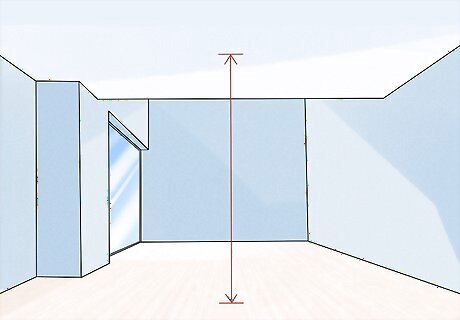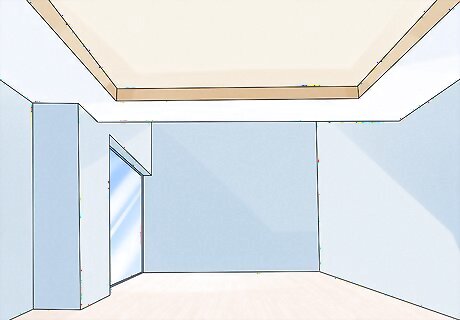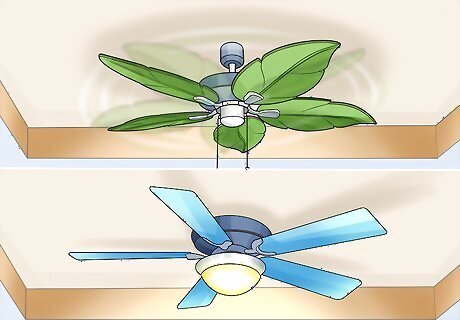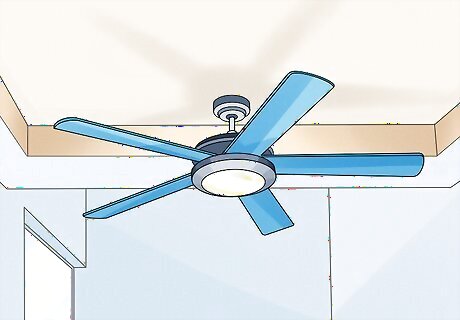
views
Sizing Your Ceiling Fan Based on Room Size

Measure the square footage of your room. This will help you determine what diameter ceiling fan will fit in the space. Measure the length and width of your room, then simply multiply the measurements together. This will give you the square footage of your room. When looking at the diameter of different brands of fan, you may find the diameter of its span listed as its "sweep."

Consult a sizing guide to determine what ceiling fan sweep will work for the square footage of your room. A guideline for sizing ceiling fans has been determined by the American Lighting Association. For rooms 75 square feet or smaller, your ceiling fan should be 36 inches (91.4 cm) or less in diameter. For rooms between 75 and 144 square feet, your ceiling fan should have a diameter of 36 to 42 inches. For larger rooms, with a square footage around 225, a 50 to 54 inch (130 to 140 cm) blade span, or even larger, are best.

Measure the height of your room. You need to install a ceiling fan high enough so that it poses no risk of hitting someone. Larger ceiling fans tend to be have a larger drop from the ceiling, so you need to take their drop into consideration when picking what size ceiling fan you want to install. The American Lighting Association recommends that you should put a ceiling fan at least 7 feet (2.1 m) above the floor. This means that you should probably not install a ceiling fan in a room that has a very low ceiling. It also means that you need to look at the drop of any ceiling fans you are considering, making sure that the lowest point of the fan will be above 7 feet (2.1 m) at minimum. Most ceiling fans come with an optional down rod, an attachment that can lower the fan away from the ceiling. If you have very tall ceilings, you may want to use it so that the fan can move the air in the room efficiently. For low ceilings, you will want to flush-mount the fan. If your ceilings are very close to 7 feet (2.1 m) tall, there are even some "hugger" or "low-profile" models.
Sizing a Ceiling Fan With Additional Factors

Assess the ceiling for possible obstacles. You will need to make sure that there are not obstacles on the ceiling that paddles could hit. Make sure there are no other lights in the way or architectural features that will create an obstacle to the rotation of the fan. If you have obstacles that cannot be moved, you may need to downsize the size of ceiling fan you install.

Determine how you want to use the fan. The purpose of a ceiling fan can vary. You can install them just for moving air around slightly or to cooling a space dramatically. If you want a lot of air movement, you will need to get a larger ceiling fan. You may want a ceiling fan that has a light integrated into it, so that it can function as a light and a fan. Ceiling fans with light kits, the term for the light fixtures attached to the bottom, will usually have a greater depth. This means that you need an even higher ceiling for a ceiling fan with a light on it, than one with without.

Think about how different size ceiling fans will look in the space. The bigger the fan, the more room it will take up and the more noticeable it will be. While there are many stylish options to choose from, taking the look into consideration when deciding on a size of ceiling fan is important. If you are concerned about a fan standing out in a space, and you are determined to get a certain size, try getting your ceiling fan in a color that matches the ceiling. It will stand out less than one in a bright or shiny color. Remember that ultimately, the diameter of your ceiling fan blades have to be compatible with the area of your ceiling.

Determine what kind of supports you have in the ceiling for your ceiling fan. Once you have decided what size fan you want, you will need to make sure that you have enough support in the ceiling to handle its weight and movement. Check if there is a power connection to the ceiling or you have to put a new electrical line and switch to run the fan. While all ceiling fans should have additional supports added to the electrical box they are connected to, larger ceiling fans usually weight more and thus will need stronger support to hang from. The manual that comes with your fan should have recommendations for ceiling supports. If you are unsure if you have enough support for the ceiling fan you choose, you might consider hiring an electrician to check and add any additional supports in the ceiling that are necessary. The weight of your ceiling fan will be dramatically different depending on its size. The weight is particularly determined by the size of the motor. A larger, stronger motor will weight a lot more than a weaker, smaller motor.



















Comments
0 comment